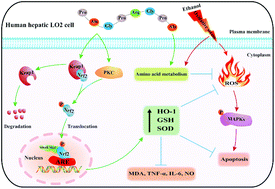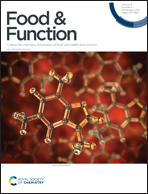The three-spot seahorse-derived peptide PAGPRGPA attenuates ethanol-induced oxidative stress in LO2 cells through MAPKs, the Keap1/Nrf2 signalling pathway and amino acid metabolism
Abstract
Alcoholic liver diseases (ALDs) impose a substantial health burden on many countries. Bioactive peptides isolated from people, marine organisms, animals and plants have shown hepatoprotective effects on animal and hepatocyte models. In this study, an LO2 cell model of ethanol-induced liver injury in vitro was constructed. We investigated the hepatoprotective effects of the three-spot seahorse bioactive peptide (SBP) PAGPRGPA (Pro-Ala-Gly-Pro-Arg-Gly-Pro-Ala; 721.39 Da) and characterised the underlying metabolic pathways and biomarkers through a nontargeted metabolomics approach. We found that ethanol-induced oxidative stress impaired the cellular antioxidant system, leading to an imbalance in cellular homeostasis. However, SBP with a certain antioxidant activity inhibited reactive oxygen species (ROS) production, excessive intracellular Ca2+ level and abnormal apoptosis. It also restored the superoxide dismutase (SOD) and glutathione (GSH) levels and attenuated ethanol-induced oxidative damage and inflammation. SBP suppressed the activation of mitogen-activated protein kinase (MAPK) in ethanol-stimulated LO2 cells. It also regulated the Kelch-like ECH-associated protein 1 (Keap1)/nuclear factor erythroid 2-related factor 2 (Nrf2) signalling pathway to protect LO2 cells from oxidative damage by promoting the expression of antioxidant enzymes, such as heme oxygenase-1 (HO-1). Furthermore, the metabolomics approach demonstrated nine different biomarkers and six metabolic pathways. In summary, the hepatoprotective mechanisms of SBP in vitro, which can be attributed to the upregulation of antioxidant substances and amino acid metabolism, attenuate ethanol-induced oxidative stress.



 Please wait while we load your content...
Please wait while we load your content...